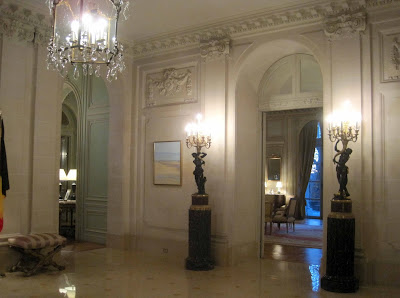The wood paneling, parquet flooring, and crystal chandeliers were all imported from France by the interior designers, Alavoine et Cie, to evoke the style of the French Regence (1715-1723). The portrait above is of the first Belgium ambassador to inhabit the house, Baron Silvercruys, who was responsible for its purchase.
While a formal room we were assured the Ambassador and his family love to use this space and entertain here frequently, evidenced by the personal photographs on the piano.
Despite the beautiful light the room receives in the evening I think I prefer it best a night when the chandeliers and lamps are lit, seen above. You can't beat that elegant ambiance.
The paneling is spectacular and in immaculate condition. It was only lightly retouched in the recent restoration.
The charming interiors look straight out of House Beautiful circa 1935. However- symmetry, as seen in the arrangement above, never goes out of style in my book!
The painted paneling allows the oak parquet floors to shine and warm the space.
From the salon one enters the Dining Room, which occupies a corner.
Again I think the room is best seen at night!
The caned chairs were recently restored and date to the 1930s.
One of the most intriguing details in the entire house are the mirrored screens in the dining room which shield the service areas, seen above flanking the chest.
If you look closer the screens are actually mirrored french doors, mimicking the other doors in the room, with false hinges, and open as a screen on one side to shield the actual leather-padded butler pantry doors. When not in use, the screens fold flat into the wall and appear to be normal French doors like the others in the room.
Above is a view of the butler's pantry with original cabinetry. Also original was the dumb waiter which carries food up from the kitchen below to this day.
I loved this chinese lamp on a built-in marble console table flanking the fireplace- perfect for serving more casual meals.
The intricate crown molding features different flowers such as daffodils and old-fashioned roses.
The paneling trophies feature spoils of the hunt.
I can't get enough of this bronze hardware!The current ambassador is a fan of wildlife and his stunning collection of Meissen birds decorate the primary spaces.
The Ambassador leaves his post in December to return home and I'm sure the house will miss his Meissen collection!
On the other side of the dining room is the former music room, now an informal dining room used daily by the Ambassador and his family. I suppose one would refer to it as the breakfast room.
The marbelized walls feature musical instruments while the shelves hold more of the Meissen collection.
The table and candlesticks are recent purchases while the chairs are original and belong to the dining room set.
The light fixtures in this space are simpler and more neo-classical in style. Notice again the use of mirrored french interior doors; in this case false to provide symmetry with the entry door from the dining room.
Even the hinges were beautiful! The faux marbeling on the walls is incredible and surely make this one of the most unique rooms of the house.






























































.jpg)





















.JPG)






































































